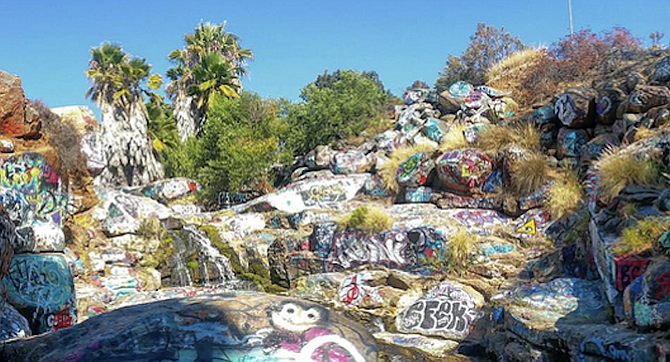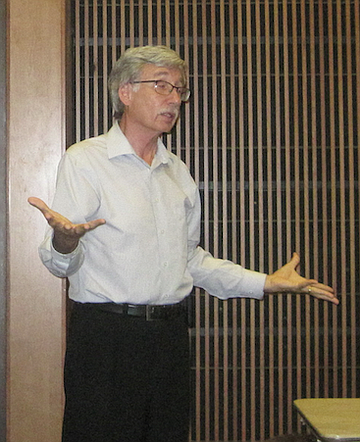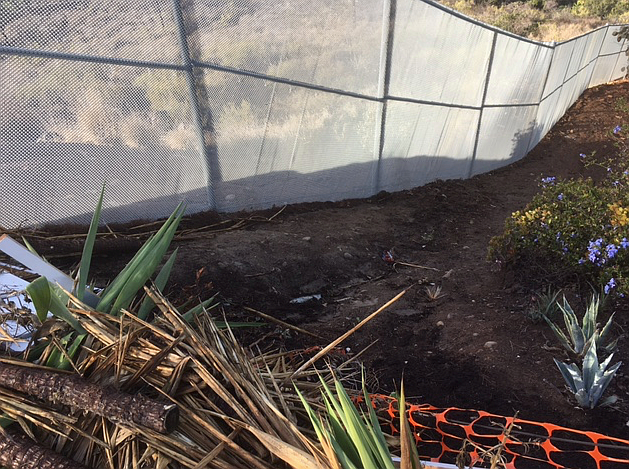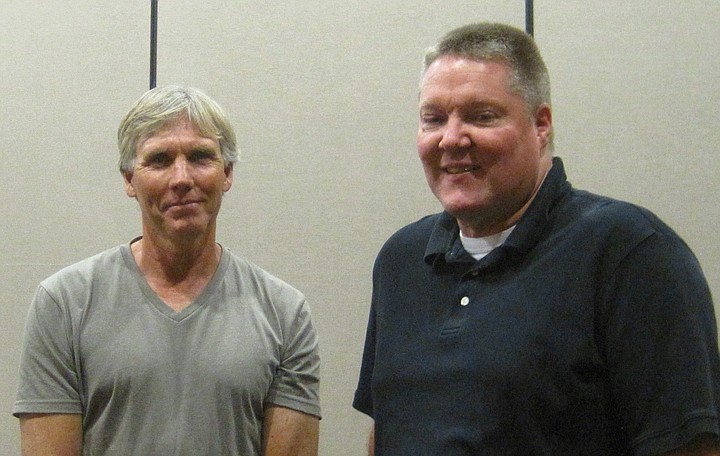 Facebook
Facebook
 X
X
 Instagram
Instagram
 TikTok
TikTok
 Youtube
Youtube

Grease, bees, and dog walks are among the methods that Del Cerro residents have used to deter trespassers from going to Adobe Falls, according to the discussion during Eric Frost’s talk at the July 27 Del Cerro Action Council meeting.

Also discussed was an opportunity for people to visit the falls, which are on land south of Del Cerro and north of westbound Interstate 8. A storm drain beneath the interstate connects the land to San Diego State University, which owns 32 of acres of land that is closed to the public. The city of San Diego owns four acres of land adjacent to the Adobe Falls Road cul-de-sac. CalTrans owns the part of the falls next to the freeway, Frost said.

While some people want to hike on the land where rocks and trees are covered with graffiti, Frost said others are there to “consume. I pick up empty beer bottles and cannabis containers. Lemon is still a favorite flavor.”

He is a Del Cerro resident, San Diego State professor, and director of the university’s Homeland Security program and the SDSU Viz (Visualization) Center. He elaborated on his talk in a July 28 phone interview.
At the meeting, Frost spoke of a “battle against the internet,” which continues to draw people to the area. “As of this morning, there were 7132 Instagram pictures of Adobe Falls. The worst thing would be if it was on Pokémon Go. Social media has changed. It used to be Twitter; [but] it's becoming passé.” People use “Kik, Snapchat, and WhatsApp.” The messaging apps are encrypted and can’t be publicly monitored.
Frost said social media may have alerted people to “come with a towel” because an “angel” puts grease on the Mill Peak Road chainlink fence to dissuade trespassers. The fence-greasing resident did not want to be identified.
He suggested several other deterrents. Noting that the graffiti message “Life is Beautiful” is the most photographed image, Frost said residents could hold a painting day to cover “art forms and make them less attractive.”
Moreover, Frost said a beehive on campus could be moved to the falls. A man in the audience said, “I put bees there; it doesn't stop people.” He declined to give his name.
There was talk about allowing access to the falls. Jay Wilson, action-council secretary, spoke about scheduling a September field trip where people could learn about elements like geologic features. Frost said the event could be a clean-up. “While walking around, pick things up.”
The field trip/clean-up will be open to the public, and details will be posted on the action council website.
Furthermore, Frost said the appointment of interim president Sally Roush could “open the door to provide answers,” with residents working with her and two others in new positions: university spokeswoman Gina Jacobs and community-relations manager Rachel Gregg.
Tackling the internet could involve showing the campus as the entrance to Adobe Falls, Frost said. Online sources including Google Maps show the entrance on Mill Peak Road.
Frost said another solution could be transferring university land to the San Diego River Conservancy.
After the meeting, two residents discussed the situation. Steve Joyce moved to Del Cerro in 2006 and noted the increase in Adobe Falls-bound people around 2014. That’s when university representatives spoke to the council about posting on websites and using social media to inform people that the land was off-limits.
Joyce said residents were further alarmed after the murder of one woman and rape of another one during a June 12, 2016, home invasion on Mill Peak Road. (According to the San Diego Union-Tribune, Eduardo José Torres, pleaded guilty on July 7, 2017, and later agreed to a life sentence. An August 4 sentencing hearing is scheduled.) l Joyce’s daily walk with his dog Mocha and his daughter’s dog Kingston is now a foot patrol.
Tom Harrison, a resident since 1985, said, “It’s been an awful experience. Many people have no respect,” damaging fences and landscaping and leaving trash behind.
Frost said in the interview, “Neighbors try to patrol the area because so many people try to go through yards.”
He elaborated on a proposal that evoked some laugher at the meeting: If Qualcomm stadium is demolished, “dump” the debris in Adobe Falls. Frost said by phone that the land south of Del Cerro represents the end of CalTrans work on I-8 during the 1960s. The university property “is a construction site that’s grown over; it isn’t a preserve.”
Frost spoke to the council last November about the study of Adobe Falls undertaken by his Homeland Security 602 graduate class.
The lessons students learned about resolving Del Cerro’s dilemma included, “You can come up with a technical solution, but the challenge is to get it through responsible parties. Often the simplest solution is no solution [doing nothing],” he said. “Maybe there’s a new answer with new people at the school.”


Grease, bees, and dog walks are among the methods that Del Cerro residents have used to deter trespassers from going to Adobe Falls, according to the discussion during Eric Frost’s talk at the July 27 Del Cerro Action Council meeting.

Also discussed was an opportunity for people to visit the falls, which are on land south of Del Cerro and north of westbound Interstate 8. A storm drain beneath the interstate connects the land to San Diego State University, which owns 32 of acres of land that is closed to the public. The city of San Diego owns four acres of land adjacent to the Adobe Falls Road cul-de-sac. CalTrans owns the part of the falls next to the freeway, Frost said.

While some people want to hike on the land where rocks and trees are covered with graffiti, Frost said others are there to “consume. I pick up empty beer bottles and cannabis containers. Lemon is still a favorite flavor.”

He is a Del Cerro resident, San Diego State professor, and director of the university’s Homeland Security program and the SDSU Viz (Visualization) Center. He elaborated on his talk in a July 28 phone interview.
At the meeting, Frost spoke of a “battle against the internet,” which continues to draw people to the area. “As of this morning, there were 7132 Instagram pictures of Adobe Falls. The worst thing would be if it was on Pokémon Go. Social media has changed. It used to be Twitter; [but] it's becoming passé.” People use “Kik, Snapchat, and WhatsApp.” The messaging apps are encrypted and can’t be publicly monitored.
Frost said social media may have alerted people to “come with a towel” because an “angel” puts grease on the Mill Peak Road chainlink fence to dissuade trespassers. The fence-greasing resident did not want to be identified.
He suggested several other deterrents. Noting that the graffiti message “Life is Beautiful” is the most photographed image, Frost said residents could hold a painting day to cover “art forms and make them less attractive.”
Moreover, Frost said a beehive on campus could be moved to the falls. A man in the audience said, “I put bees there; it doesn't stop people.” He declined to give his name.
There was talk about allowing access to the falls. Jay Wilson, action-council secretary, spoke about scheduling a September field trip where people could learn about elements like geologic features. Frost said the event could be a clean-up. “While walking around, pick things up.”
The field trip/clean-up will be open to the public, and details will be posted on the action council website.
Furthermore, Frost said the appointment of interim president Sally Roush could “open the door to provide answers,” with residents working with her and two others in new positions: university spokeswoman Gina Jacobs and community-relations manager Rachel Gregg.
Tackling the internet could involve showing the campus as the entrance to Adobe Falls, Frost said. Online sources including Google Maps show the entrance on Mill Peak Road.
Frost said another solution could be transferring university land to the San Diego River Conservancy.
After the meeting, two residents discussed the situation. Steve Joyce moved to Del Cerro in 2006 and noted the increase in Adobe Falls-bound people around 2014. That’s when university representatives spoke to the council about posting on websites and using social media to inform people that the land was off-limits.
Joyce said residents were further alarmed after the murder of one woman and rape of another one during a June 12, 2016, home invasion on Mill Peak Road. (According to the San Diego Union-Tribune, Eduardo José Torres, pleaded guilty on July 7, 2017, and later agreed to a life sentence. An August 4 sentencing hearing is scheduled.) l Joyce’s daily walk with his dog Mocha and his daughter’s dog Kingston is now a foot patrol.
Tom Harrison, a resident since 1985, said, “It’s been an awful experience. Many people have no respect,” damaging fences and landscaping and leaving trash behind.
Frost said in the interview, “Neighbors try to patrol the area because so many people try to go through yards.”
He elaborated on a proposal that evoked some laugher at the meeting: If Qualcomm stadium is demolished, “dump” the debris in Adobe Falls. Frost said by phone that the land south of Del Cerro represents the end of CalTrans work on I-8 during the 1960s. The university property “is a construction site that’s grown over; it isn’t a preserve.”
Frost spoke to the council last November about the study of Adobe Falls undertaken by his Homeland Security 602 graduate class.
The lessons students learned about resolving Del Cerro’s dilemma included, “You can come up with a technical solution, but the challenge is to get it through responsible parties. Often the simplest solution is no solution [doing nothing],” he said. “Maybe there’s a new answer with new people at the school.”
Comments